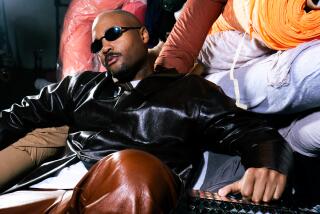TRAVELING IN STYLE : A SENSE OF PLACE : What is important with travel pictures is not only to show what is there but to give your viewers a feeling of being there, a sample of what you saw, what struck your fancy andhow you reacted to it.
- Share via
Twenty-some years ago when I first traveled to Europe, I had a new camera, a gift from a generous grandmother. My head was full of Ingmar Bergman and Federico Fellini film images, because their works were my visual influence.
My father watched in disbelief as I shot one odd, obscure, artsy photograph after another. One day he reminded me that I had promised to show my grandmother my photos, and that she might not recognize a cat curled in sleep against a window ledge as being a uniquely Dutch cat on a distinctly Amsterdam window ledge next to a canal.
Annoyed but properly warned, I started shooting pictures a little less “artistic,” a little more “post card-like.” Those shots showed the scenes, but they showed more than that. Years, and many travels later, that humbling photo lesson of the ‘60s still holds.
What is important with travel pictures is not only to show what is there but to give your viewers a sense of being there, a sample of what you saw, what struck your fancy and how you reacted to it. The best photographs should make you want to get into the next plane, train or automobile and head to that spot to see it for yourself.
Shoot the general views, the “post card” pictures, but don’t stop there. Walk into your post card and find what it is that catches your eye and your interest. It is these little details, the small things, that give your viewers the sense of the place. Shoot the canals of Amsterdam, and keep your eyes peeled for cats asleep in the windows. Notice how the old window glass ripples (the effect of hand-rolled glass made long ago) and how those ripples make interesting distorted reflections of the view across the canal. Then look across the canal and notice the buildings mirrored in the water.
But it only begins there. If you’re fortunate enough to stay in any one place for more than a day, pay attention to the light. Notice the way everything looks when you leave your hotel in the morning, and how it’s different when you come back to drop off packages at lunch and again when you return before dinner at dusk. As the sun moves across the sky, it dramatically changes the way scenes look, starting cool and austere in the morning, changing to hard, brutal and direct at noon, and becoming warm and flattering in late afternoon. Even rain has an exciting effect; don’t forget the camera on those days. Streets shine in the rain, and electric lights inside stores and homes look warm and inviting to the eye--and even more so on film.
Unless you are interested only in architectural studies, don’t exclude people from your pictures. Years later you can look at the photos and marvel at the clothing styles, but more immediately people serve to give the picture a sense of scale.
As they move through your picture, people often become additional design and composition elements as you shoot at one instant or another, waiting a moment for them to walk across the street or piazza, balancing the composition against some other element in your shot.
Wherever I stay, I try to get a room high up in the hotel or inn, with a view of the street or square below. I love to eavesdrop on the world from up high and shoot down on the patterns of traffic in the street. Dawn and dusk shots are more interesting, too, when you can see up or down the street, catching the street lights and store signs at the last light of day. Sometimes you can literally eavesdrop on the rooftops and residents’ lives as they tend their gardens or their laundry. It all gives a flavor of what life is like, a sense of the place.
If you have access to a darkroom, try shooting print film, especially black-and-white. For me, the feeling of a place often comes across more clearly when the distraction of color is removed. And some of the travels I treasure most have been the six- or eight-hour trips spent in the darkroom working on the prints weeks after I’ve returned.
More to Read
Sign up for The Wild
We’ll help you find the best places to hike, bike and run, as well as the perfect silent spots for meditation and yoga.
You may occasionally receive promotional content from the Los Angeles Times.






